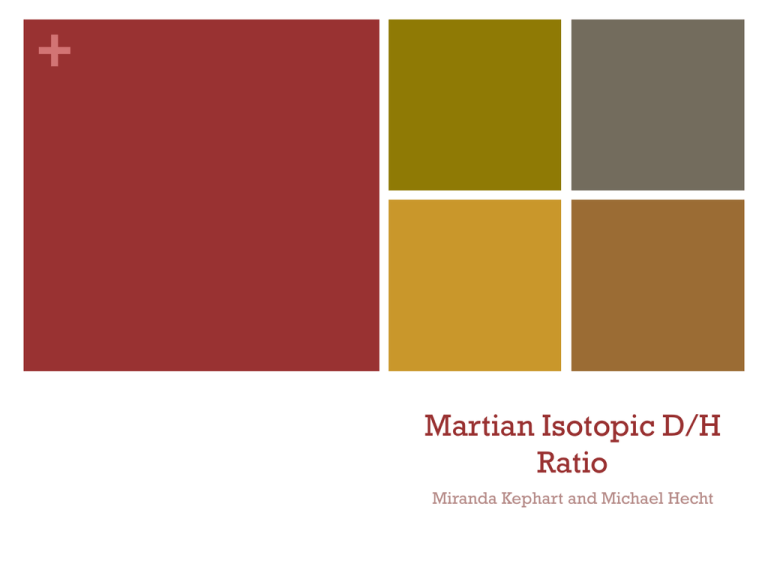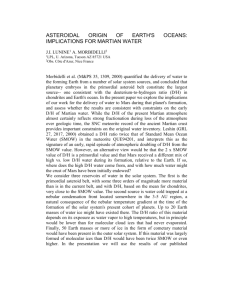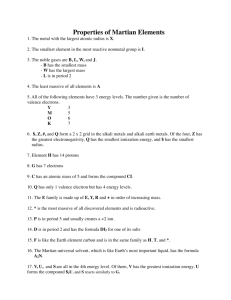+ Martian Isotopic D/H Ratio Miranda Kephart and Michael Hecht
advertisement

+ Martian Isotopic D/H Ratio Miranda Kephart and Michael Hecht + Climate Study Using Isotopologues Isotopologues of common molecules (such as water) are often used on earth as a probe of climatic variations (geographically and with time). Oxygen isotopes (16O/18O) and deuterium/hydrogen (D/H) ratios are used to track the terrestrial paleoclimate (e.g. ice cores) On Earth, changes we observe are measured relative to the ocean water. We want to determine a Martian standard for the ratio of hydrogen isotope abundances. + Earth temperatures derived from benthic 16O/18O ratio and Vostok ice core D/H ratio line up + What Can D/H Tell Us? Understand relationship between water in the atmosphere and ground reservoirs Determine current D/H values at various locations Track geographic and seasonal variations, and compare to paleoclimatic measurements Understand ‘long history’ of Mars’s water ‘Fingerprint’ and track air masses + Martian Atmospheric D/H Generally measured relative to SMOW (Standard Mean Ocean Water) D/H Past measurements have been between 2 and 10 times SMOW Only recently has it been suggested that the D/H ratio might vary geographically + Observations Data collected using the SMA (an interferometric array covering the short millimeter and sub-millimeter wavelengths) on April 26, 2014 (Ls = 122.8) Two spectral lines: HDO (225.9 GHz transition) and H218O (203.4 GHz) At time of observations, Mars had a sub-Earth latitude of 23.2 degrees Data are averaged in longitude, but not in local time + Lineshape Fitting After initial calibration (performed by Dr. Mark Gurwell at the CfA), spectral cubes were produced The spectra at each pixel were averaged around the limb and fit with a Lorentzian lineshape (due to collisional broadening) Then, each pixel was fit for a scale height, relative to the overall lineshape, producing maps of the relative line emission across the field of view. + HDO and H2-18O Intensity + D/H Ratio + Temperature Profiles The observed intensity at a particular point depends on abundance AND temperature contrast. If the surface is cold relative to the atmosphere, the observed emission will be stronger. To account for this, temperature models were used to correct the ratios. Model temperature and pressure profiles were input into a radiative transfer code (written by Dr. Gurwell) to obtain radius-dependent spectra. + Beam Weighting + Results The temperature profile corrections have little effect on the results. + + Conclusions D/H decreases from north to south D/H ratios are somewhat lower than past literature (~3 vs. ~5.5) If there are no systematic errors in our measurements, and the past globally averaged value of 5.5 is correct, our data support the hypothesis that there are geographic variations in D/H This is a probe of the D/H ratios in the various martian water reservoirs + Acknowledgements Michael Hecht and Mark Gurwell Phil Erikson and Vincent Fish and everyone at Haystack! + Questions?



